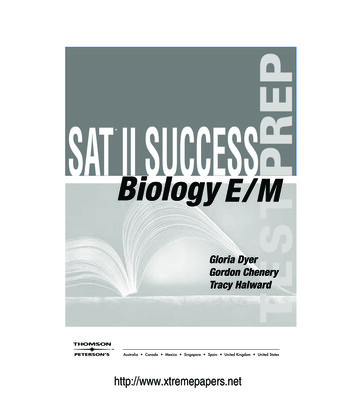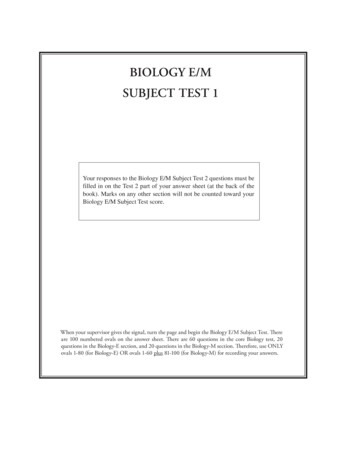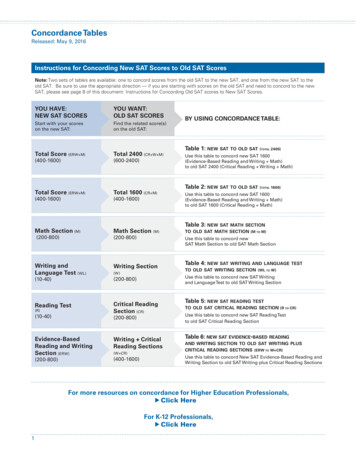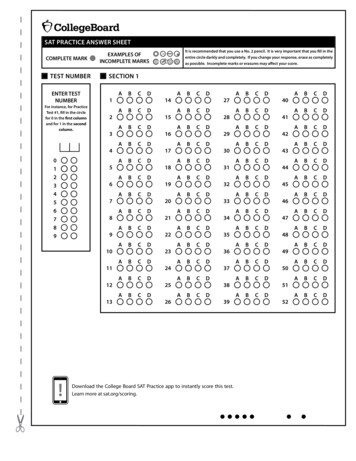
Transcription
http://www.xtremepapers.net
About The Thomson Corporation and Peterson’sWith revenues of US 7.2 billion, The Thomson Corporation (www.thomson.com) is a leading global provider of integratedinformation solutions for business, education, and professional customers. Its Learning businesses and brands(www.thomsonlearning.com) serve the needs of individuals, learning institutions, and corporations with products andservices for both traditional and distributed learning.Peterson’s, part of The Thomson Corporation, is one of the nation’s most respected providers of lifelong learning onlineresources, software, reference guides, and books. The Education SupersiteSM at www.petersons.com—the Internet’smost heavily traveled education resource—has searchable databases and interactive tools for contacting U.S.-accreditedinstitutions and programs. In addition, Peterson’s serves more than 105 million education consumers annually.Editorial Development: American BookWorks CorporationContributing Editor: Barbara MaynardFor more information, contact Peterson’s, 2000 Lenox Drive, Lawrenceville, NJ 08648; 800-338-3282; or find us on theWorld Wide Web at www.petersons.com/about.COPYRIGHT 2002 Peterson’s, a division of Thomson Learning, Inc.Thomson Learning is a trademark used herein under license.Previous editions 2000, 2001ALL RIGHTS RESERVED. No part of this work covered by the copyright herein may be reproduced or used in any formor by any means—graphic, electronic, or mechanical, including photocopying, recording, taping, Web distribution, orinformation storage and retrieval systems—without the prior written permission of the publisher.For permission to use material from this text or product, contact us byPhone: 800-730-2214Fax: 800-730-2215Web: www.thomsonrights.comISBN 0-7689-0907-4Printed in the United States of America1098765432 104 03 02
CONTENTSRED ALERT . . . . . . . . . . . . . . . . . . . . . . . . . . . . . . . . . . . . . . . . .1About this Book . . . . . . . . . . . . . . . . . . . . . . . . . . . . . . . . . . . . . . .1About the Test . . . . . . . . . . . . . . . . . . . . . . . . . . . . . . . . . . . . . . . . .2SAT II Biology Study Plan . . . . . . . . . . . . . . . . . . . . . . . . . . . . . .3Panic Plan . . . . . . . . . . . . . . . . . . . . . . . . . . . . . . . . . . . . . . . . . . . .6Systems of Measurement . . . . . . . . . . . . . . . . . . . . . . . . . . . . . . .7DIAGNOSTIC TEST . . . . . . . . . . . . . . . . . . . . . . . . . . . . . . . . . .11UNIT I—MOLECULES AND CELLS . . . . . . . . . . . . . . . . . . . .33Chapter 1: Chemistry—Atoms and Compounds. . . . . . . . . .35Chapter 2: Cells—Organization and Regulation . . . . . . . . . .59Chapter 3: Energy for Life—Anabolism and Catabolism . .75UNIT II—HEREDITY AND EVOLUTION . . . . . . . . . . . . . . .91Chapter 4: Genetics—Mendel and Heredity . . . . . . . . . . . . . .93Chapter 5: Molecular Genetics—DNA and Evolution . . . . .115UNIT III—ORGANISMS AND POPULATIONS . . . . . . . .141Chapter 6: Organisms and Populations . . . . . . . . . . . . . . . . .143Chapter 7: Animals—Structure and Function . . . . . . . . . . . .169Chapter 8: Behavior and Ecology . . . . . . . . . . . . . . . . . . . . . . .197Chapter 9: Laboratory . . . . . . . . . . . . . . . . . . . . . . . . . . . . . . . . .215PRACTICE TEST 1 . . . . . . . . . . . . . . . . . . . . . . . . . . . . . . . . . . .223PRACTICE TEST 2 . . . . . . . . . . . . . . . . . . . . . . . . . . . . . . . . . . .261PRACTICE TEST 3 . . . . . . . . . . . . . . . . . . . . . . . . . . . . . . . . . . .295ANSWER SHEETS . . . . . . . . . . . . . . . . . . . . . . . . . . . . . . . . . . .327iii
RED A LERTABOUT THIS BOOKAlmost a quarter of a million students take SAT II Subject Tests(previously known as the College Board Achievement Tests) everyyear. Many colleges require SAT II Subject Test scores. The purposeof these tests is to measure and demonstrate your knowledge and/orskills in specific subjects and to test your ability to apply thatknowledge on each particular examination. The better your score is,the better your application will look to the colleges of your choice.If you’re reading this book, it’s likely that you are preparing forone of the SAT II Biology exams. We have tried to make this a“workable” book. In other words, the book is set up so that, regardless of the level exam you’re taking, you will be able to find thematerial necessary to study and to take those tests that are mostapplicable to your level.Divided into sections, the book begins with a diagnostic biologyexam. The purpose of this diagnostic test is to help you get a handleon what you know and what needs more work. Take this exam (andall of the tests) under simulated exam conditions, if you can. Whatthis means is that you should find a quiet place in which to work, setup a clock, and take the test without stopping. When you arefinished, take a break and then go back and check your answers.Always reread those questions you got wrong, since sometimes anerror can come from merely misreading the question. Again, doublecheck your answers, and if they’re still not clear, read the appropriatesection in the review material.Once you’ve completed your Diagnostic Test, it’s time to moveon to the biology review section. Study the material carefully, but feelfree to skim those portions of the review section that are easiest foryou.Then, take the Practice Tests. There are three simulated examsdesigned to give you a broad spectrum of question-types, similar tothose you will find on the actual SAT II Biology test. We suggest thatregardless of whether you plan to take the E (ecological) or M(molecular) version of the test, it would be extremely helpful to takeall of the tests in the book. In this way you will have a much broaderPeterson’s n SAT IISuccess: Biology E/MRED1ALERTwww.petersons.com
RED ALERTperspective of the exam and may even surprise yourself as to howmuch you actually know about each level.As you complete each exam, take some time to review youranswers. We think you’ll find a marked improvement as you workthrough the Diagnostic Test and complete all of the full-lengthpractice tests. Always take the time to check the review section forclarification, and if you still don’t understand the material, go to yourteacher for help.ABOUT THE TESTThe Biology E/M test contains 60 general biology questions followedby 20 questions in each of the special sections: Biology E or BiologyM. You can select the area in which you feel most confident, and,after completing the 60 core questions, you can then take either theEcological or Molecular sections. That selection can be made whenyou take the test by filling in the appropriate code for the section youwish to take. You cannot take both sections on the same test date.The test covers the following areas.Cellular and Molecular Biology — 12%Ecology — 12%Classical Genetics — 10%Organismal Biology — 30%Evolution and Diversity — 11%Ecology/Evolution (Biology E Test) — 25%Molecular/Evolution (Biology M Test) — 25%In order to take this test and do well, you should have completed atleast a one-year course in biology. In addition, it would be helpful tohave also taken algebra, in order for you to understand basic algebraicconcepts. Since you will not be allowed to use a calculator whiletaking this test, it is also important to have basic mathematical skills,although the calculations you will encounter will be fairly simple. Inaddition, you will encounter some questions utilizing the metricsystem, so you should brush up on this topic.TAKINGTHETESTSince you will have 60 minutes in which to complete the exam, it isimportant that you pace yourself. One important item to remember isto be thoroughly familiar with the directions for the tests so that youdon’t waste time trying to understand them once you’ve opened yourtest booklet.Work through the easy questions first. The faster you cancomplete those questions, the more time you’ll have for those thatare more difficult. You may use your test book for scratch paper, butwww.petersons.comRED2ALERTPeterson’s n SAT IISuccess: Biology E/M
RED ALERTkeep your answer sheet clean; since they are machine-readable, anystray marks might be misconstrued as an answer.The questions are all multiple choice, with five lettered choices.As with any multiple-choice test, you should approach each questionby first trying to select the correct answer. If the answer is clear toyou, select it at once. If you’re unsure, the first technique is theprocess of elimination. Try to cross off any answers that don’t seemto make sense or that you know are completely wrong. This improves your odds of guessing the correct answer. If, for example, youcan eliminate three choices, you have a 50/50 chance of guessing thecorrect answer. Otherwise, if you can’t eliminate any choices, youhave only a 20 percent rather than a 50 percent chance of getting theanswer correct.SCORINGWhile it’s not imperative that you completely understand how thetest is scored, since the process shouldn’t deter you from trying to doyour best, you are probably aware that the scores are reported on the200–800 point range.Each question answered correctly receives one point. You willlose a fraction of a point for each wrong answer. However, you willnot lose points if you don’t answer a question. (Make sure that if youskip any answers, the next question you answer is filled in on youranswer page in the correct space.) Thus, it makes sense to guess atthose questions that you don’t know, and of course, as with mostmultiple-choice questions, you should use the process of eliminationto increase the odds of guessing correctly. The more choices youeliminate, the better are your odds for choosing the correct answer.SAT II BIOLOGY STUDY PLANThe most important thing you should have when preparing for theSAT II Biology exam is a plan. To start, you should estimate howmuch time you have before the exam. If you have enough time toprepare completely, you’ll be okay. If, however, you’re somewhatshort on time, this plan will be even more valuable for you. We offeryou these different study plans to help maximize your time andstudying. The first is a 9-Week Plan, which involves concentratedstudying and a focus on the practice test results. The second is themore leisurely 18-Week Plan, one that’s favored by schools. Finally, iftime is running short, you should use the Panic Plan. We don’t wantyou to panic, however—this plan is supposed to help you conquerthat panic and help you organize your studying so that you can getthe most out of your review work and still be as prepared as possiblewhen it is time to take the test.Peterson’s n SAT IISuccess: Biology E/MRED3ALERTwww.petersons.com
RED ALERTThese plans are supposed to be flexible and are only suggestions. Feel free to modify them to suit your needs and your ownstudy habits. But start immediately, because the more you study andreview, the better your results will be.THE 9-WEEK PLAN—TWO LESSONS PER WEEKWeek 1 Lesson 1—Diagnostic Test. The diagnostic SAT II Biology test isdesigned to help you determine what you need to know and whereto focus your studying. Take this test under simulated test conditions in a quiet room, and keep track of the time it takes tocomplete the test. The diagnostic test has only 50 questions (30general biology, 10 M-level, and 10 E-level). Regardless of whichspecific test (E or M) you intend to take, you should answer all ofthe questions on the diagnostic test to get an idea of the areas inwhich you’re weakest. Lesson 2—Diagnostic Test Answers. Once you have completedthe test, spend this lesson carefully checking all of your answersand reading through the explanations. This may take a bit of time,but it will enable you to select those subject areas that you shouldfocus on and the areas on which you should spend the mostamount of time studying. Armed with this information, you canstart reviewing the chapters in the rest of the book.Week 2 Lesson 1—Chapter One: Chemistry—Atoms and Compounds.Take your time to read through the first chapter. Note that thestyle of the review material is in an outline format. It should besimilar to your classroom notes. Underline or use a marker tohighlight those areas that are unclear to you. Lesson 2—Chapter Two: Cells—Organization and Regulation.Again, read through this chapter, mark whatever is unclear, and goback and reread the material if necessary.Week 3 Lesson 1—Chapter Three: Energy for Life—Anabolism andCatabolism. As you continue your lessons, try to study in a quietroom, uninterrupted by others in your house or the TV, radio, orany other noises. Lesson 2—Chapter Four: Genetics—Mendel and Heredity.Again, read through this chapter, mark whatever is unclear, and goback and reread the material if necessary.www.petersons.comRED4ALERTPeterson’s n SAT IISuccess: Biology E/M
RED ALERTWeek 4 Lesson 1—Chapter Five: Molecular Genetics—DNA andEvolution. You’re approaching the halfway point in the contentchapters of this book now, so continue reading and taking notes.You can, of course, break these lessons into sections. Work on halfthe chapter in the morning and the other half in the afternoon. Lesson 2—Chapter Six: Organisms and Populations. Readthrough this chapter, mark whatever is unclear, and then go backand reread the material if necessary. You can always ask yourteacher for additional information if you’re having difficulty.Week 5 Lesson 1—Chapter Seven: Animals—Structure and Function.Chapters 7 and 8 are the last ones that cover the subject matterthat will be on the test. By now, you should have a strong understanding of the material. Lesson 2—Chapter Eight: Behavior and Ecology. This is thefinal part of your journey into the subject review of SAT II Biology.All that’s left is one more chapter that can help you improve yourscores on the actual exam.Week 6 Lesson 1—Chapter Nine: The Laboratory. While laboratoryexercises are not on the test itself, you must have a workingknowledge of lab techniques in order to do well on this exam. Thischapter will cover most of what you have already practiced in yourclassroom. Lesson 2—Review. This is the time to take a breather and go backand look over the content chapters of the book in order to findanything that might have slipped by. Look at the illustrations. Doyou understand them? Try to answer some questions from earlierchapters. How did you do? You still have some time before takingthe practice tests.Week 7 Lesson 1—Practice Test 1. Answer as many of the questions asyou can, and then guess at those you don’t know. Circle thosequestions that you guessed at so you can zero in on those specificanswers and so you don’t delude yourself into thinking that youreally knew those answers in the first place. Answer the questionsin the General Biology section first, and then answer all of thequestions in each of the E and M portions of the exam. It’simportant to evaluate what you know. Lesson 2—Practice Test 1 Answers. Check all of your answers toboth parts of the test.Peterson’s n SAT IISuccess: Biology E/MRED5ALERTwww.petersons.com
RED ALERTWeek 8 Lesson 1—Practice Test 2. Take this test and answer as many ofthe questions as you can. By now, you will have noticed howmuch you have improved since you took the diagnostic test. Lesson 2—Practice Test 2 Answers. Check your answers to bothparts of the test.Week 9 Lesson 1—Practice Test 3. This is the final test. After taking thistest you will have answered 300 multiple-choice questions on thesethree practice tests as well as 50 more on the diagnostic test.Although there may be some new material on the actual test thatyou haven’t encountered here, you should be very well prepared. Lesson 2—Practice Test 3 Answers. Check your answers to bothparts of the test, and then relax!THE 18-WEEK PLAN—1 LESSON PER WEEKIf you’re lucky enough to have the extra time, the 18-Week Plan willenable you to better utilize your study time. You will now be able tospread out your plan into one lesson a week. This plan is idealbecause you are not under any pressure and you can take more timeto review the material in each of the chapters. You will also haveenough time to double-check the answers to those questions thatmight have given you problems. Keep in mind that the basis for alltest success is practice, practice, practice.THE PANIC PLANWe hate using this term, and while we hope you don’t fall into thiscategory, not everyone has the luxury of extra time to prepare for theSAT II Biology test. Perhaps, however, we can offer you a few helpfulhints to get you through this difficult and stressful period.Read through the official SAT II Biology bulletin and this SAT IISuccess: Biology book, and memorize the directions. One way ofsaving time on any test is to be familiar with the directions so youcan maximize the time you have to work on the questions. On thistest, they’re pretty simple.Read the introduction to this book. It will be helpful in preparing for the test and will give you an understanding of what you canexpect on the exam and how much time you will have to completeboth sections of the test.Take the diagnostic test as well as the practice tests.Focus whatever time you have left on those specific areas thatgave you the most difficulty when you took the practice tests.www.petersons.comRED6ALERTPeterson’s n SAT IISuccess: Biology E/M
RED ALERTWhatever time you have before the exam, keep in mind that themore you practice, the better you will do on the final exam.Good luck!SYSTEMS OF MEASUREMENTSome of the questions you will encounter on the SAT II Biology E/Mtest will involve measurements in both the English and the metricsystems. Following is a brief review of the material. We suggest youreview these few pages and answer the practice questions we’veprovided before you take the diagnostic and practice tests or beginstudying the biology review chapters in this book.THE ENGLISH SYSTEMWhen taking the SAT II Biology exam, you will need to be able tocompute using both the English system of measurement and themetric system. It may also be necessary for you to convert measurements from one system to the other, but in such cases, you will begiven the appropriate conversion factors.Make sure you have the following relationships within theEnglish system memorized:Conversion Factors for Length36 inches 5 3 feet 5 1 yard12 inches 5 1 foot5,280 feet 5 1,760 yards 5 1 mileConversion Factors for Volume2 pints 5 1 quart16 fluid ounces 5 1 pint8 pints 5 4 quarts 5 1 gallonConversion Factors for Weight16 ounces 5 1 pound2,000 pounds 5 1 tonThese conversion factors enable you to change units within theEnglish system.Examples1. How many feet are in 5 miles?5 miles (5,280 feet/1 mile) 5 26,400 feetPeterson’s n SAT IISuccess: Biology E/MRED7ALERTwww.petersons.com
RED ALERTNotice how the unit of “miles” cancels out of the numerator anddenominator.2. How many ounces are in 2 tons?2 tons (2,000 pounds/1 ton) (16 ounces/1 pound) 564,000 ouncesNotice how the units of “tons” and “pounds” cancel out of thenumerator and denominator.THE METRIC SYSTEMIn the metric system, distance or length is measured in meters.Similarly, volume is measured in liters, and mass is measured ingrams. The prefixes below are appended to the beginning of thesebasic units to indicate other units of measure with sizes equal to eachbasic unit multiplied or divided by powers of 0 1centi510 2milli510 3micro510 6nano510 9pico510 12From the table above, we can see, for example, that a kilometer is1,000 times as long as a meter, 100,000 times as long as a centimeter,and 1,000,000 times as a long as a millimeter. Similarly, a centigram is1the size of a gram.100Conversions among metric units can be made quickly by movingdecimal points.Examples1.Convert 9.43 kilometers to meters.Since meters are smaller than kilometers, our answer will belarger than 9.43. There are 1,000 meters in a kilometer, so wemove the decimal point three places over to the right. 9.43kilometers is equal to 9,430 meters.www.petersons.comRED8ALERTPeterson’s n SAT IISuccess: Biology E/M
RED ALERT2.Convert 512 grams to kilograms.Since kilograms are more massive than grams, our answer mustbe less than 512. There are 10 3 kilograms in a gram, so wemove the decimal point three places to the left. 512 grams areequal to .512 kilograms.CONVERSIONSBETWEEN THE ENGLISH AND THE METRIC SYSTEMSConversions between the English and metric systems are accomplished in the same way as conversions within the English system.Recall that any problem that requires you to make such a conversionwill include the necessary conversion factors.Examples1. If 1 meter is equivalent to 1.09 yards, how many yards are in 10meters?10 meters (1.09 yards/1 meter) 5 10.9 yards2. If 1 yard is equivalent to .914 meters, how many meters arethere in 24 yards?24 yards (.914 meters/1 yard) 5 21.936 metersSYSTEMSOFMEASUREMENT PROBLEMS1. Express 38 meters in millimeters.2. Express 871 millimeters in centimeters.3. Which measurement is greater, 8,000 millimeters or 7 meters?4. Arrange the following from smallest to biggest: 6,700 meters,672,000 centimeters, and 6.6 kilometers.5. Express 49 milligrams in centigrams.6. 4.6 liters is how many milliliters?7. A package weighing 32.5 kilograms is shipped to the U.S. Whatis its weight in pounds? There are 2.2 pounds in a kilogram.8. A line drawn on a blueprint measures 1.5 yards. What is itslength in meters? There are .914 meters in a yard.9. If the distance between two exits on a highway is 40 kilometers,what is the distance in miles? There are .62 miles in a kilometer.10. A particular brand of bottled water is available in two differentbottle sizes—a 2.25 quart bottle and a 2.1 liter bottle. Whichbottle contains more water? There are 1.06 quarts in a liter.Peterson’s n SAT IISuccess: Biology E/MRED9ALERTwww.petersons.com
RED ALERTSOLUTIONS1. Since meters are larger than millimeters, our answer will belarger than 38. There are 1,000 millimeters in a meter, so wemove the decimal point three places over to the right. 38 metersis equal to 38,000 millimeters.2. Since millimeters are smaller than centimeters, our answer willbe smaller than 871. There are 10 millimeters in a centimeter, sowe move the decimal point one place over to the left. 871millimeters is equal to 87.1 centimeters.3. In order to answer this question, we must express both measuresin the same units. Since, for example, 8,000 millimeters is equalto 8 meters, we can see that 8,000 millimeters is larger than 7meters.4. Let’s start by expressing all measurements in meters.672,000 centimeters56,720 meters6.6 kilometers56,600 meters6,700 meters56,700 metersThus, from smallest to largest, we have 6.6 kilometers, 6,700meters, and 672,000 centimeters.5. Since there are 10 milligrams in a centigram, 49 milligrams isequal to 4.9 centigrams.6. Since there are 1,000 milliliters in a liter, there are 4,600 milliliters in 4.6 liters.7. 32.5 kgs 5 32.5 kgs (2.2 lbs/1 kg) 5 71.5 lbs8. 1.5 yards 5 1.5 yards (.914 meters/1 yard) 5 1.371 meters9. 40 kilometers 5 40 kilometers (.62 miles/1 kilometer) 5 24.8miles10. Express 2.1 liters in quarts.2.1 liters 5 2.1 liters (1.06 quarts/1 liter) 5 2.226 quarts. Thus,the quart bottle holds more.www.petersons.comRED10ALERTPeterson’s n SAT IISuccess: Biology E/M
DIAGNOSTIC TESTWhile you have taken many standardized tests and know to blacken completely the ovals on theanswer sheets and to erase completely any errors, the instructions for the SAT II exam in Biologydiffers from the directions for other standardized tests you have taken. You need to indicate on theanswer key whether you are taking the SAT II Biology with Ecological Emphasis (Biology-E) orMolecular Emphasis (Biology-M).The instructions on the answer sheet will tell you to fill out the top portion of the answer sheetexactly as shown.1. Print BIOLOGY-E or BIOLOGY-M on the line to the right under the words Subject Test(print).2. In the shaded box labeled Test Code fill in four ovals:For BIOLOGY-E—Fill in oval 1 in the row labeled V.For BIOLOGY-M—Fill in oval 1 in the row labeled V.Test CodeTest Code42367895Þ �OÞOÞÞA23DE15CX OÞOÞOÞÞ OÞY OÞÞ OÞOÞOÞ42367895Þ �OÞOÞÞA23DE15CX OÞOÞOÞÞ OÞY OÞÞ 23678915OÞOÞOÞOÞOÞOÞOÞOÞOÞSubject Test (print)Subject Test (print)BIOLOGY-EBIOLOGY-M—Fill in—Fill in—Fill in—Leaveoval 9 in the row labeled W.oval 4 in the row labeled X.oval B in the row labeled Y.the ovals in row Q blank.—Fill in—Fill in—Fill in—Leaveoval 9 in the row labeled W.oval 4 in the row labeled X.oval B in the row labeled Y.the ovals in row Q blank.3. When everyone has completed filling in this portion of the answer sheet, the supervisor willtell you to turn the page and begin. The answer sheet has 100 numbered ovals on the sheet,but there are only 90 (or 95) multiple-choice questions in the test, so be sure to use onlyovals 1 to 90 (or 95) to record your answers.Peterson’s n SAT IISuccess: Biology E/M11www.petersons.com
DIAGNOSTIC TESTDIAGNOSTIC TEST—ContinuedDirections: Each of the questions or statements below is accompanied by five choices. For eachquestion, select the best of the answer choices given.1. Which of the following statements aboutmitochondria is NOT correct?3. What would happen to a human red bloodcell if it was placed in distilled water?(A) They serve as sites for cellular respiration.(A) It would shrivel.(B) They are enclosed by a double membrane.(C) It would lyse.(C) They are the sites where most of thecell’s ATP is produced.(E) It would not be affected.(B) It would plasmolyze.(D) It would dehydrate.(D) They are found in animal cells only;plant cells have chloroplasts instead.4. Which of the following pairs does NOTrepresent a correct relationship?(E) They are found in eukaryotic cells butnot in prokaryotic cells.(A) fat; lipid(B) starch; polysaccharide(C) starch; carbohydrate2. Which of the following statements aboutcell structure is NOT correct?(D) sugar; carbohydrate(E) enzyme; lipid(A) Plant cells have cell walls, whereasanimal cells do not.(B) Ribosomes are the main sites of energyproduction for the cell.5. Which of the following statements iscorrect?(C) Plant cells have chloroplasts, whereasanimal cells do not.(A) The product of transcription is DNA.(D) Lysosomes function in the digestion ofcellular waste products.(C) The product of transcription is apolypeptide.(E) Many cellular organelles are interrelated through an endomembranesystem.(D) The product of translation is mRNA.(B) The product of transcription is mRNA.(E) The product of translation is DNA. GO ON TO THE NEXT PAGEPeterson’s n SAT IISuccess: Biology E/M13www.petersons.com
DIAGNOSTIC TESTDIAGNOSTIC TEST—Continued6. Which of the following is responsible forchanges in the Earth’s seasons?9. The use of specially bred strains of bacteriato clean up oil spills along beaches is anexample of(A) The tilt of the Earth’s axis toward oraway from the sun.(A) primary succession.(B) The distance between the Earth and thesun at different times of the year.(B) bioremediation.(C) The movement of the oceans’ currents.(D) coevolution.(D) The annual cycles of temperature andrainfall.(E) eutrophication.(E) The variation in the amount of energyreleased by the sun from month tomonth.(C) decomposition.10. In the food chain illustrated below, whichtrophic level is represented by the earthworm?7. The two fundamental processes that governthe dynamics of an ecosystem aresunflower — caterpillar —bluejay — tomcat — earthworm(A) primary consumer(A) solar radiation and the carbon cycle.(B) secondary consumer(B) photosynthesis and respiration.(C) tertiary consumer(C) the carbon cycle and photosynthesis.(D) quaternary consumer(D) energy flow and chemical/nutrientcycling.(E) decomposer(E) the nitrogen cycle and the phosphorouscycle.8. A host plant produces a toxin that is lethalto aphids feeding on its leaves. Over time,some of the aphids become immune to thetoxin. In response, the host plant begins toproduce a different toxin that is lethal toaphids. This is an example of(A) parasitism.11. Which of the following statements aboutmeiosis is correct?(A) The result of meiosis is a zygote.(B) Only somatic cells undergo meiosis.(C) Meiosis restores the original diploidcondition of a population.(D) Meiosis typically results in geneticvariation among the gametes produced.(E) The products of meiosis are always fourcells identical to the parent cell.(B) commensalism.(C) predation.(D) mutualism.(E) coevolution.www.petersons.com14Peterson’s n SAT IISuccess: Biology E/M
DIAGNOSTIC TESTDIAGNOSTIC TEST—Continued12. An animal organism with a diploid numberof chromosomes equal to 30 wouldnormally13. The results of the above cross indicate thatamong the original parents (P-generation)(A) not be able to undergo meiosis becausegametes would end up with an oddnumber of chromosomes.(B) produce two gametes with 30 chromosomes each during meiosis.(C) produce four gametes with 30 chromosomes each during meiosis.(D) produce two gametes with 15 chromosomes each during meiosis.(E) produce four gametes with 15 chromosomes each during meiosis.Questions 13–14 refer to the followingbreeding experiment. The researcher’s goalwas to develop white mice with short tails.Pbrown micewith short tailsx white mice with long tailsF1all offspring arebrown and havelong tailsF2 2929710336micemicemicemicearearearearebrown with long tailsbrown with short tailswhite with long tailswhite with short tails(A) both were heterozygous for coat colorand tail length.(B) one was homozygous dominant for coatcolor and tail length, whereas the otherwas homozygous recessive for bothtraits.(C) one was homozygous dominant for coatcolor and homozygous recessive for taillength, whereas the other was homozygous
The Biology E/M test contains 60 general biology questions followed by 20 questions in each of the special sections: Biology E or Biology M. You can select the area in which you feel most confident, and, after completing the 60 core questions, you can then take either the Ecological or Molecular sections. That selection can be made when










